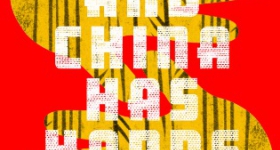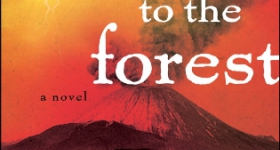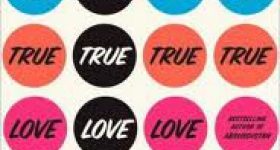Memory
does not, and cannot, function as a direct transcription of what has happened
to us in the past. It is perhaps understandable, then, that Amarnath Ravva
chooses to employ several other forms of documentation in his debut work, American Canyon, which is multimedia in
every sense of the word. Using stills from filmed rituals and recorded
interviews with family members and holy men alike, Ravva carefully reconstructs
on the page a past that belongs to both him and those whose lives have given
rise to his.
The
resulting narrative -- part-memoir, part-documentary, part-mythical exposition
-- is a fragmented collage in much the same way that Ravva professes to be a
man of hybrid tradition and innovation himself. The content informs the form.
An
Indian American who grew up in Northern California, Ravva confesses early on to
feeling that something was missing from his being, much like the “American
grain,” which he likens to “a hollow trunk.”
“Only
the outer rings remain,” he writes. “We cut away what doesn’t belong. Our
methods, our mechanical eyes and surgical hands, treat symptoms because origins
overwhelm us.”
This
sentiment of unexplainable loss is a significant one because Ravva spends the
entirety of the narrative struggling to fill that hole with stories and
histories and myths that he gathers over the course of ten years in India. He
doesn’t seem to mind being overwhelmed by the discovery of origins; he is
unafraid to deep-dive into the past in order to better understand his present,
even if what he finds is uncomfortable and, at times, almost claustrophobic in
its sheer volume. In this way, then, he interrogates from all angles rather
than simply seeking a superficial salve for his unease.
The
premise of the narrative can feel foggy at times, in that Ravva plays with the
murky depths of memory, but the gist of it is this:
Ravva
undergoes numerous rituals, in part to get closer to his family’s past, and in
part to try to shake off the bad omen that clings to his being, as “seen” by
his mother’s seer, Sharma. He has a hard time believing the seer’s
proclamation, but thinks it might have a lot to do with his status as a
second-generation Indian American, tainted by the ambivalences of being neither
solely Indian nor solely American.
“He said
I have a naga dosham, like Nayanamma,” he writes. “Unlike karma, which is the
fruit of what your soul did in its previous life, a naga dosham is the result
of prarabdha karma. Prarabdha karma is the fruit of your actions during this
life. It is immediate retribution.”

Amarnath Ravva
And thus
begins his journey to discover just what this bad luck is, and how and why
Nayanamma, his maternal grandmother, had it too. In his quest to find an
answer, he recounts and references some well-known myths that include the Hindu
epic Ramayana and the Hindu god Rama’s siege with an army of monkeys. But
whether the reader is familiar or not with these myths is less relevant than,
say, whether the reader can trust in a narrator who is constantly conflating
his personal narrative with stories made up of more magical realism elements.
The
answer, based on the deft hand with which Ravva guides the reader in and out of
his memories -- both personal and collective -- is a resounding yes.
Ravva
serves as more of an observer than an active participant throughout the novel,
and begins his tale with what is presumably a selection of stills from a video
he took of his time in Rameswaram. This, however, is hardly the beginning of
his journey; no, it is somewhere in the middle -- and this constant sensation
of floating in and out of time is not an altogether unpleasant one. Many of the
scenes feel dream-like and their order seems to matter less than the fact that
they exist at all.
The
incorporation of video time stamps throughout the book are helpful guideposts
for the reader to find his or her way back to the main narrative, though it is
arguable that everything is the “main narrative,” since everything is very much
connected.
He
explains at one point that during his years-long documentation of Indian
rituals, he once lost all of his DV tapes and hard drive after someone stole
the backpack they were kept in, essentially wiping clean hours, days, months of
capture. The loss, however, turned out to be a metaphor in disguise, for though
the thief might have tried to record over the original footage, the first
encryptions will always remain.
“The
past is written over with new ones and zeros,” he writes. “An entry in the
index is created so they can be found again. This new data is stored randomly,
and all around it are dispossessed strings of numbers that have no entry, have
no name to be called by anymore. …We imagine the rest of the poem. We dream of
the sky that is missing.”
And
perhaps, in the end, it is because Ravva is so aware of his inability to ever
fully capture the past and its significant impact on the present that gives the
reader license to trust his words. He is self-aware in his writing and in his
observations, and he is, above all else, concerned with both capturing and
recognizing the limits of capturing, the present.
For the
truth that he seems to state is one that all readers can relate to: memory will
always be incomplete, and layered, and complicated and there’s beauty to be
found in its disintegration.
Joyce Chen is a second-generation
Taiwanese American journalist and an MFA candidate in Creative Nonfiction at
The New School in New York City. Her writings have been published in People
magazine, the New York Daily News, Us Weekly, Los Angeles magazine, the Los
Angeles Daily News, and Narratively, among others.









Comments